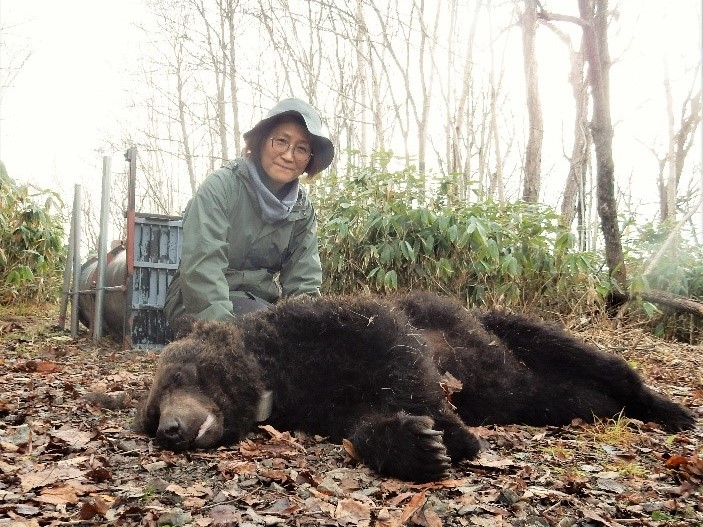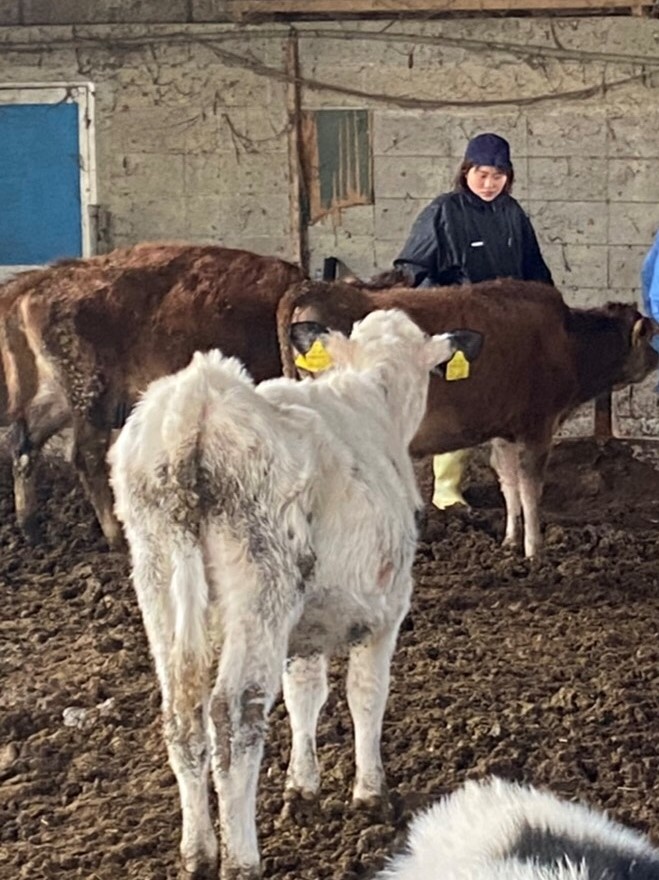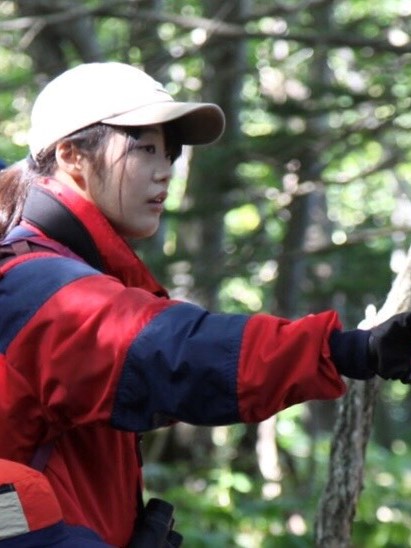 (Graduation ceremony. April, 2022)
(Graduation ceremony. April, 2022)

Toshio TsubotaProfessor
35 years have passed since I became involved with bears, but little is known about their physiology and ecology. I'd like to plunge into research on bears for a while longer. I hope to spread the word about the role of bears and other wild animals in nature and about their interesting ecology.
Research themes
- Relationship between bear nutrition and reproduction
- Management and conservation of bears in Asia
- Relation between ecology and infectious diseases of wild animals

Michito ShimoZuruAssociate Professor
I do ecological studies of brown bears on the Shiretoko Peninsula during summer, and I do physiological studies of hibernating Asian black bears. Using two different approaches, I'd like to pursue the biology of bears, which are very interesting animals.
Research themes
- Metabolic mechanism of Asian black bears during hibernation
- The reproductive system of brown bears in the Rusha area of the Shiretoko Peninsula

Mariko SashikaAssistant Professor
I've conducted research on issues related to alien species, such as raccoons. Above all, I've focused on the measures against infection from alien species to native species (mainly raccoon dogs) and humans.
Research themes
- Measures to address issues related to alien species and infectious diseases of wild animals

Rika KikuchiOffice worker

Chihiro TakahataAcademic researcher
I am interested in "predators" because of their ecological traits generally drawing humans' fear and aversion. Particularly, I suppose that a long-term conflict management critically needs a novel approach to the background conflict mechanism including human-land use. For this, I am exploring the way of effective habitat management for the mitigation of human-carnivore conflict.
Research themes
- Habitat selection of large carnivores on the periphery of human-disturbed landscape.

Xiaofei LuoD4
Research themes
- Study on regulation of body temperature, heart rate and endocrinology during hibernation in male Japanese black bear.

Rajan PaudelD3
I studied forestry for my undergraduate degree and biodiversity and environmental management for my masters. Before coming to Hokkaido, I worked for 4 years mostly in biodiversity assessments, project reporting and proposal development. My previous research has involved population estimation of Swamp partridge, camera trapping of Snow leopards and Tigers, and regeneration studies of Rhododendrons. I want my work to contribute to understanding landscapes that support diverse wildlife, ecosystems and people, and promote development in harmony with nature. I like nature photography, travelling, eating and drinking with friends. Reach me at: rajanpoudel093@gmail.com
Research themes
- Ecology and Genetic diversity of Sloth bears in Nepal

Arjun PanditD2
I am interested in various diseases condition in wild animals, and I will focus mainly in elephant tuberculosis of Nepal. During my PhD study, I am planning to do surveillance study of elephant tuberculosis and develop the protocol to diagnose elephant tuberculosis from fecal sample of elephants as non-invasive methods.
Research themes
- Elephant tuberculosis in the captive-wildlife interface of Nepal

Kotaro ShimizuD2
I am from Kagoshima University. Hokkaido is cold. When I was an undergraduate student, I was a member of the Reproduction laboratory and did research on dolphin sperm. Now I am studying tick-borne diseases in wild animals. My hobbies are reading, anime and manga. The picture shows me playing softball in a suit. Softball is not my hobby.
Research themes
- Investigation of host and vector factors on the infection rate of tick-borne diseases in wildlife

Rishi BaralD1
I studied Zoology, specializing ecology and environment from Central department of Zoology, Tribhuvan University, Kritipur, Nepal for my masters. I have worked 6 and half years in National Trust for Nature Conservation (NTNC), Annapurna Conservation Area Project (ACAP), Nepal on biodiversity research and community base conservation of wildlife before coming to Hokkaido. From NTNC-ACAP, I led the long-term monitoring of forest study plots in the Chitwan - Annapurna Landscape (CHAL) to study how climate change is affecting forest ecosystems. My previous research has involved camera trapping to survey medium to large mammals in high mammalian species, King Cobra conservation and its nest monitoring, Sherman trapping to monitor small rodents, mist net for bats, bird point count, transect surveys, herpeto fauna surveys, butterfly transect surveys, and pitfall sampling for insects. Simultaneously, I also lead the faunal biodiversity assessment team in the Chure Range of Nepal, where we conduct similar surveys of biodiversity. All these research experiences have helped me to develop my skills in field of wildlife. I like travelling, photography and talking with friends. Reach me at: rightbaral@gmail.com
Research themes
- Genetic Structure and Ecology of Himalayan brown bears in Himalaya, Nepal

Anastasiia KovbaD1
Nice to meet you! My name is Anastasiia Kovba. I am from Ukraine and I received my Bachelor degree in Veterinary Medicine there. I then graduated with the Master of Science degree from Kyoto University, where I studied HIV/AIDS. I am interested in the emerging infectious diseases and zoonosis research, as well as in the wildlife conservation, therefore I joined the Wildlife Biology and Medicine lab in Hokkaido University as a PhD student in April 2022. My hobbies are photography, playing piano, painting, traveling and reading.
Research themes
- Infectious status of COVID-19 and other zoonosis in urban wildlife and zoo animals in Hokkaido area

Miku MinamikawaV6
Hi, I'm studying about wild raccoons in the central part of Hokkaido. They are invasive species in Japan so I'm going to do research how they could spread the virus. The photo is not related to my research, but my favorite one with cows!
Research themes
- An epidemiological survey on canine distemper virus (CDV) infection in raccoons of Hokkaido, Japan

Yuu AmadaV6
I am studying to establish a method to detect microorganisms infecting large wild mammals using DNA from blood. I like outdoor activities such as mountain climbing, fishing, and diving. The photo is from the Five Lakes of Shiretoko.
Research themes
- Establishment of a method for detecting eukaryotic microorganisms in large mammals, brown bears, Hokkaido deer, and harbor seals

Shiori NakamuraV6
I'm studying brown bears in captivity and in the wild using their DNA, participating in fieldwork in Shiretoko. Recently, I'd like to become more sensitive to animal tracks and to be able to identify different types of trees.
Research themes
- Age estimation based on DNA methylation of brown bear

Mebuki ItoV5
I'm interested in the invasive species and entered the university. Then I was interested in infectious diseases and am studying disease ecology in raccoon. I used to watch birds until a while ago, but these days I watch reptiles, though I want to watch mammals.
Research themes
- Ecology of YEZV in raccoons and ticks

Joshaniel TanResearch Student
I am a Singaporean research student who graduated from the University of Oregon with a degree in Environmental Science and a minor in Biology. I am interested in animal behavior, specifically large predators, and wildlife conservation. I hope to facilitate human-wildlife interactions by reducing conflict between our species, in order to maintain population levels in the wild.
Research themes
- Wildlife behavior and conservation of brown bears in the Shiretoko Peninsula


 (Graduation ceremony. April, 2022)
(Graduation ceremony. April, 2022)













